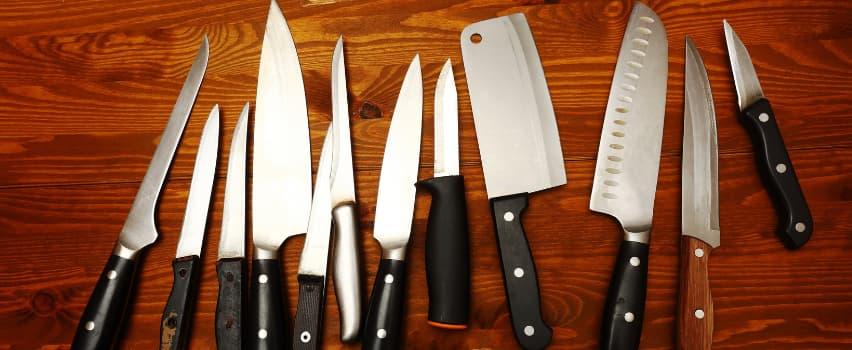Our guide to choosing the very best filleting knife in the UK
Here at Butchers Equipment Warehouse, we supply filleting knives from some of the world’s most prestigious manufacturers, including Swibo and Victorinox. All of these knives are built to exacting standards, and possess an unrivalled edge sharpness and durability, which allows them to capably perform in the most intensive butchery environments.
Our filleting knives are an important addition to make to any butchers shop - but what features distinguish a filleting knife? What’s the difference between a boning knife and a filleting knife for fish? How can you determine if a boning knife is suitable for use?
You may well already know at least some of the answers to the questions posed above – but if you just fancy a refresher, here’s our expert’s guide to choosing the very best filleting knives for your business.
What is a filleting knife?
Primarily used for cutting poultry into thin slices, filleting knives are specifically designed to easily remove skin from meat. The design of the filleting knife plays a vital role in ensuring a smooth, clean cut for your produce, particularly when slicing more delicate meats like chicken and fish.
What makes the best filleting knife in the UK?
When deciding on what kind of filleting knife you want to purchase, certain attributes need to be considered to ensure you get the right kind for your business. Of course, professional knives do cost more than your average filleting knife, but they’re worth the extra investment due to their reliability and longevity.
So, what makes professional filleting knives the best option? Here are a few reasons:
Material - the material of the blade you’re using can have big implications on the quality of the cut it produces. Ideally, you want a stainless steel blade with a high-carbon content. Why high-carbon? Well this will help to protect your blade from corrosion from seawater, since filleting knives are often used on fish.
Thin, sharp, flexible blades - filleting knives have a unique blade structure. For starters, the blades are extremely thin, as they’re designed to remove meat while leaving bone intact. This is because the thinner blade offers much better control and flexibility. Plus, the blades are extremely sharp, largely because the blade is usually sat at an angle of twelve - seventeen degrees (in other words, razor sharp).
Blade length - the blade length for a filleting knife ranges from 6 to 11 inches. As we touched on above, filleting knives come in different blade lengths to match the size of the fish. Shorter blades are great for smaller fish, while longer blades are ideal for cutting and skinning larger fish.
Handle type - filleting knife handles are traditionally made out of wood, however knives with high-quality plastic or rubber handles are also very common. Wooden handles are extremely sturdy and add weight to the knife, but Fibrox plastic handles add extra grip for the user. Plastic and rubber handles offer a much stronger grip, and are also much easier to clean. Ergonomically shaped handles also improve the grip on the knife while relieving user fatigue.
Flexibility and its importance
One of the most crucial aspects of a high-quality filleting knife is its flexibility. A flexible blade allows you to navigate the contours of the fish with ease, making it easier to remove the skin and separate the flesh from the bones without causing damage to the delicate meat. This flexibility is especially beneficial when working with different species of fish, as it enables you to adapt your technique based on the size and shape of the fish.
For instance, a more flexible blade is ideal for filleting smaller, delicate fish like trout, where precision is key to avoid tearing the flesh. On the other hand, if you’re working with larger fish such as salmon or tuna, a slightly stiffer blade may provide the necessary control for more substantial cuts. Therefore, considering the type of fish you typically work with will help you select the appropriate level of flexibility in your filleting knife.
Recommended brands and models
When investing in a filleting knife, it’s wise to consider reputable brands that are known for their quality and craftsmanship. Some of the top brands in the market include:
- Icel: This Portuguese brand is celebrated for producing high-quality knives with an emphasis on craftsmanship and functionality. Icel filleting knives feature ergonomic handles and sharp, flexible blades, designed for precise filleting tasks, making them a trusted choice among both professionals and enthusiasts.
- Fischer: Known for its professional-grade knives, Fischer offers a range of filleting knives designed for durability and performance. These blades are crafted from high-quality stainless steel, ensuring they maintain sharpness and flexibility even in demanding environments, making them ideal for rigorous butchery work.
- Swibo: Renowned for the exceptional edge retention and durability of its knives, Swibo is a favourite among professionals. Its filleting knives are designed with a high-carbon stainless steel blade that offers both flexibility and sharpness, perfect for delicate cuts and intricate filleting.
- Victorinox: Famous for its Swiss Army knives, Victorinox also produces high-quality filleting knives. These knives are known for their lightweight design and ergonomic handles, making them a great choice for long hours in the kitchen. They offer a balance of practicality and reliability, suitable for both home cooks and professional chefs.
Maintaining your filleting knife
Proper maintenance is vital for ensuring the longevity and performance of your filleting knife. Here are some essential tips for keeping your knife in prime condition:
Let’s start with sharpening techniques. Regular sharpening is crucial to maintain a sharp edge. Invest in a good quality whetstone or honing rod, and make it a habit to sharpen your knife before and after each use. The ideal angle for sharpening a filleting knife is typically between 15 and 20 degrees. A sharp knife not only makes filleting easier but also improves safety, as a dull knife can lead to accidents.
Now, it’s time to move on to cleaning. Always clean your knife after each use to prevent any residue build-up. Hand washing with warm, soapy water is recommended, as dishwashers can dull the blade and cause damage. Gently wipe the blade with a non-abrasive sponge, and avoid soaking the knife in water for extended periods, as this can lead to rust.
Finally, proper storage is essential to keep your filleting knife safe and sharp. A dedicated knife block, magnetic strip, or protective sheath can help protect the blade from damage. Avoid storing your knife loose in a drawer, where it can bump against other utensils and become dull.
All of our filleting knives are designed with state-of-the-art production technology, and of course all available at the very best prices right here at Butchers Equipment Warehouse. You can explore our extensive range of butchers knives and butchers equipment right here on our site. Give us a call on 01254 427721 and we’ll be happy to answer any questions you may have.




